Optimization and Evaluation of the Weather Research and Forecasting (WRF) Model for Wind Energy Resource Assessment and Mapping in Iran
Abstract
1. Introduction
2. Materials and Methods
2.1. Study Area, Data and Wind Measuring Stations
- (i)
- Ten-meter wind data in meteorological stations: In order to comprehensively assess the model results, we selected 140 weather stations distributed across the country. After conducting quality control on the synoptic data, we narrowed down our selection to 110 stations (as shown in Figure 1) that had complete data available from 2004 to 2020, which were then compared with the wind simulations generated by the model.
- (ii)
- Data from upper air stations (UAS): The studied area comprises approximately 10 UAS. However, these stations are not operational on a continuous basis and often have gaps in their data records. Most of these stations conduct observations at specific times, either at 00 UTC or 1200 UTC. Additionally, the available data from these stations had a time step of 10 s, and the stations did not provide wind data at heights near the ground surface for model verification purposes. Fortunately, data with a time step of 2 s were successfully extracted from four UAS (as shown in Figure 1) for the months of January and July 2013, which were then utilized for verifying the model results.
- (iii)
- Meteorological mast data: Data from five meteorological masts (Figure 1) were utilized to verify the model results.
- (iv)
- Available data from the Global Wind Atlas: To compare the simulated wind results with those from The Technical University of Denmark (DTU) Wind Atlas, data from 2008 to 2017 were used.
2.2. Model Description
2.3. Model Setup
2.4. Sensitivity Analysis
- (i)
- The YSU scheme is widely utilized for its ability to handle a diverse range of atmospheric conditions. It employs a non-local closure approach and incorporates both local and non-local mixing processes within the boundary layer. The YSU scheme’s notable feature is its use of a prognostic equation for turbulent kinetic energy.
- (ii)
- The MYJ scheme combines elements of local and non-local closures and adopts an eddy diffusivity approach to represent turbulent mixing. This scheme also includes a counter-gradient term to account for buoyancy effects.
- (iii)
- The MYNN2.5 scheme is an advanced extension of the MYJ scheme, aiming to enhance the representation of the vertical structure of the boundary layer. It introduces additional prognostic equations for turbulent kinetic energy and incorporates a higher-order closure for sub-grid-scale turbulence.
- (iv)
- QNSE Scheme: In contrast to the previous schemes, the QNSE scheme adopts a different approach based on quasi-normal scale elimination. It explicitly solves equations for turbulent kinetic energy and its dissipation rate, allowing for a more precise representation of boundary layer processes. The QNSE scheme effectively captures the effects of both local and non-local turbulent mixing.
- (v)
- ACM2 Scheme: Designed specifically for weather and climate prediction models, the ACM2 scheme focuses on representing convective processes within the boundary layer. It employs a multi-plume approach to simulate convective updrafts and downdrafts, enabling a more realistic representation of convective phenomena.
2.5. Verification of the Model Results
- (1)
- Information regarding temporal co-variability is provided here through the root mean square error (RMSE), which estimates systematic biases in the model skill, aswhere “y” is the simulated wind speed, “o” is the wind speed observation at the same place and time, and “n” is the total number of the values’ pairs.
- (2)
- “Bias” is a common statistical error for comparing the wind speed distribution between observations and model simulations.
- (3)
- The Standard Deviation Error (STDE),
2.6. Wind Energy Production Estimation
3. Results and Discussion
3.1. Sensitivity Analysis
3.2. Mapping of the Wind Energy Potential
3.3. Trend Analysis of the Wind Energy Potential
3.4. Evaluation of the WRF Simulations
4. Conclusions
Supplementary Materials
Author Contributions
Funding
Institutional Review Board Statement
Informed Consent Statement
Data Availability Statement
Acknowledgments
Conflicts of Interest
References
- Osobajo, O.A.; Otitoju, A.; Otitoju, M.A.; Oke, A. The Impact of Energy Consumption and Economic Growth on Carbon Dioxide Emissions. Sustainability 2020, 12, 7965. [Google Scholar] [CrossRef]
- Balint, T.; Lamperti, F.; Mandel, A.; Napoletano, M.; Roventini, A.; Sapio, A. Complexity and the economics of climate change: A survey and a look forward. Ecol. Econ. 2017, 138, 252–265. [Google Scholar] [CrossRef]
- Fouquet, R. Lessons from energy history for climate policy: Technological change, demand and economic development. Energy Res. Soc. Sci. 2016, 22, 79–93. [Google Scholar] [CrossRef]
- Yin, Z.; Liu, Z.; Liu, X.; Zheng, W.; Yin, L. Urban heat islands and their effects on thermal comfort in the US: New York and New Jersey. Ecol. Indic. 2003, 154, 110765. [Google Scholar] [CrossRef]
- Shang, K.; Xu, L.; Liu, X.; Yin, Z.; Liu, Z.; Li, X.; Yin, L.; Zheng, W. Study of Urban Heat Island Effect in Hangzhou Metropolitan Area Based on SW-TES Algorithm and Image Dichotomous Model. SAGE Open 2023, 13, 21582440231208851. [Google Scholar] [CrossRef]
- Tizpar, A.M.; Satkin, B.; Roshan, M.; Armoudli, Y. Wind Resource Assessment and Wind Power Potential of Mil-E Nader Region in Sistan and Baluchestan Province, Iran–Part 1: Annual Energy Estimation. Energy Convers. Manag. 2014, 79, 273–280. [Google Scholar] [CrossRef]
- GWEC. Global Wind Report: Annual Market Update 2017; Global Wind Energy Council: Brussels, Belgium, 2018. [Google Scholar]
- GSR, E.S.; Azees, M.; Vinodkumar, C.R.; Parthasarathy, G. Hybrid optimization enabled deep learning technique for multi-level intrusion detection. Adv. Eng. Softw. 2018, 173, 103197. [Google Scholar]
- Zhao, J.; Zhenhai, G.; Yanling, G.; Ye, Z.; Wantao, L.; Jianming, H. Wind Resource Assessment Based on Numerical Simulations and an Optimized Ensemble System. Energy Convers. Manag. 2019, 201, 112164. [Google Scholar] [CrossRef]
- SATBA. Statistics of RE Power Plants, Renewable Energy and Energy Efficiency Organization. 2019. Available online: https://www.satba.gov.ir/en/investmentpowerplants/statisticsofrepowerplants (accessed on 4 December 2023).
- Chiras, D. Power from the Wind: Achieving Energy Independence; New Society Publishers: Gabriola Island, BC, Canada, 2009. [Google Scholar]
- Carvalho, D.; Rocha, A.; Santos, C.S.; Pereira, R. Wind resource modelling in complex terrain using different mesoscale–microscale coupling techniques. Appl. Energy 2013, 108, 493–504. [Google Scholar] [CrossRef]
- Badger, J.; Frank, H.; Hahmann, A.N.; Giebel, G. Wind-climate estimation based on mesoscale and microscale modeling: Statistical-dynamical downscaling for wind energy applications. J. Appl. Meteor. Climatol. 2014, 53, 1901–1919. [Google Scholar] [CrossRef]
- Peterson, E.W.; Joseph, P.H., Jr. On the Use of Power Laws for Estimates of Wind Power Potential. J. Appl. Meteorol. 1978, 17, 390–394. [Google Scholar] [CrossRef]
- Stull, R.B. An Introduction to Boundary Layer Meteorology; Springer Science & Business Media: Berlin/Heidelberg, Germany, 2012; Volume 13. [Google Scholar]
- Zhao, Y.; Li, J.; Zhang, L.; Deng, C.; Li, Y.; Jian, B.; Huang, J. Diurnal cycles of cloud cover and its vertical distribution over the Tibetan Plateau revealed by satellite observations, reanalysis datasets, and CMIP6 outputs. Atmospheric Meas. Tech. 2023, 23, 743–769. [Google Scholar] [CrossRef]
- Siuta, D. An Analysis of the Weather Research and Forecasting Model for Wind Energy Applications in Wyoming. Ph.D. Thesis, Department of Atmospheric Science, University of Wyoming, Laramie, WY, USA, 2013. [Google Scholar]
- Do-Yong, K.; Jin-Young, K.; Jae-Jin, K. Mesoscale Simulations of Multi-Decadal Variability in the Wind Resource over Korea. Asia-Pac. J. Atmos. Sci. 2013, 49, 183–192. [Google Scholar]
- Giannaros, T.M.; Melas, D.; Ziomas, I. Performance evaluation of the Weather Research and Forecasting (WRF) model for assessing wind resource in Greece. Renew. Energy 2017, 102, 190–198. [Google Scholar] [CrossRef]
- Galvez, G.H.; Flores, R.S.; Miranda, U.M.; Martínez, O.S.; Téllez, M.C.; López, D.A.; Gómez, A.K.T. Wind resource assessment and sensitivity analysis of the levelised cost of energy. A case study in Tabasco, Mexico. Renew. Energy Focus 2019, 29, 94–106. [Google Scholar] [CrossRef]
- Jared, L.; Doubrawa, P.; Xue, L.; J Newman, A.; Draxl, C.; George Scott, G. Wind Resource Assessment for Alaska’s Offshore Regions: Validation of a 14-Year High-Resolution WRF Data Set. Energies 2019, 12, 2780. [Google Scholar] [CrossRef]
- Carvalho, D.; Rocha, A.; Gómez-Gesteira, M.; Santos, C. A sensitivity study of the WRF model in wind simulation for an area of high wind energy. Environ. Model. Softw. 2012, 33, 23–34. [Google Scholar] [CrossRef]
- Penchah, M.M.; Malakooti, H. The eastern-Iran wind-resource assessment through a planetary boundary layer simulation (2011–2015). Wind. Eng. 2019, 44, 253–265. [Google Scholar] [CrossRef]
- Hamzeh, N.H.; Ranjbar Saadat Abadi, A.; Chel Gee Ooi, M.; Habibi, M.; Schöner, W. Analyses of a Lake Dust Source in the Middle East through Models Performance. Remote Sens. 2022, 14, 2145. [Google Scholar] [CrossRef]
- Hamzeh, N.H.; Shukurov, K.; Mohammadpour, K.; Kaskaoutis, D.G.; Saadatabadi, A.R.; Shahabi, H. A comprehensive investigation of the causes of drying and increasing saline dust in the Urmia Lake, northwest Iran, via ground and satellite observations, synoptic analysis and machine learning models. Ecol. Inform. 2023, 78, 102355. [Google Scholar] [CrossRef]
- Abadi, A.R.S.; Hamzeh, N.H.; Shukurov, K.; Opp, C.; Dumka, U.C. Long-term investigation of aerosols in the Urmia Lake region in the Middle East by ground-based and satellite data in 2000–2021. Remote Sens. 2022, 14, 3827. [Google Scholar] [CrossRef]
- Hamzeh, N.H.; Abadi, A.R.S.; Kaskaoutis, D.G.; Mirzaei, E.; Shukurov, K.A.; Sotiropoulou, R.E.P.; Tagaris, E. The Importance of Wind Simulations over Dried Lake Beds for Dust Emissions in the Middle East. Atmosphere 2023, 15, 24. [Google Scholar] [CrossRef]
- Janjai, S.; Masiri, I.; Promsen, W.; Pattarapanitchai, S.; Pankaew, P.; Laksanaboonsong, J.; Bischoff-Gauss, I.; Kalthoff, N. Evaluation of wind energy potential over Thailand by using an atmospheric mesoscale model and a GIS approach. J. Wind. Eng. Ind. Aerodyn. 2014, 129, 1–10. [Google Scholar] [CrossRef]
- Nor, K.M.; Shaaban, M.; Rahman, H.A. Feasibility assessment of wind energy resources in Malaysia based on NWP models. Renew. Energy 2014, 62, 147–154. [Google Scholar] [CrossRef]
- Charabi, Y.; Al Hinai, A.; Al-Yahyai, S.; Al Awadhi, T.; Choudri, B.S. Offshore wind potential and wind atlas over the Oman Maritime Zone. Energy, Ecol. Environ. 2019, 4, 1–14. [Google Scholar] [CrossRef]
- Dörenkämper, M.; Olsen, B.T.; Witha, B.; Hahmann, A.N.; Davis, N.N.; Barcons, J.; Ezber, Y.; García-Bustamante, E.; González-Rouco, J.F.; Navarro, J.; et al. The Making of the New European Wind Atlas—Part 2: Production and evaluation. Geosci. Model Dev. 2020, 13, 5079–5102. [Google Scholar] [CrossRef]
- Hahmann, A.N.; Sīle, T.; Witha, B.; Davis, N.N.; Dörenkämper, M.; Ezber, Y.; García-Bustamante, E.; González-Rouco, J.F.; Navarro, J.; Olsen, B.T.; et al. The making of the New European Wind Atlas—Part 1: Model sensitivity. Geosci. Model Dev. 2020, 13, 5053–5078. [Google Scholar] [CrossRef]
- Ashrafi, K.; Motlagh, M.S.; Neyestani, S.E. Dust storms modeling and their impacts on air quality and radiation budget over Iran using WRF-Chem. Air Qual. Atmos. Health 2017, 10, 1059–1076. [Google Scholar] [CrossRef]
- Nabavi, S.O.; Haimberger, L.; Samimi, C. Sensitivity of WRF-chem predictions to dust source function specification in West Asia. Aeolian Res. 2017, 24, 115–131. [Google Scholar] [CrossRef]
- Foroushani, M.A.; Opp, C.; Groll, M.; Nikfal, A. Evaluation of WRF-Chem Predictions for Dust Deposition in Southwestern Iran. Atmosphere 2020, 11, 757. [Google Scholar] [CrossRef]
- Yu, E.; Bai, R.; Chen, X.; Shao, L. Impact of physical parameterizations on wind simulation with WRF V3.9.1.1 over the coastal regions of North China at PBL gray-zone resolution. Geosci. Model Dev. 2022, 15, 8111–8134. [Google Scholar] [CrossRef]
- Njuki, S.M.; Mannaerts, C.M.; Su, Z. Influence of Planetary Boundary Layer (PBL) Parameterizations in the Weather Research and Forecasting (WRF) Model on the Retrieval of Surface Meteorological Variables over the Kenyan Highlands. Atmosphere 2022, 13, 169. [Google Scholar] [CrossRef]
- Arregocés, H.A.; Rojano, R.; Restrepo, G. Sensitivity analysis of planetary boundary layer schemes using the WRF model in Northern Colombia during 2016 dry season. Dyn. Atmos. Oceans 2021, 96, 101261. [Google Scholar] [CrossRef]
- Diaz, L.R.; Santos, D.C.; Käfer, P.S.; Iglesias, M.L.; da Rocha, N.S.; da Costa, S.T.L.; Kaiser, E.A.; Rolim, S.B.A. Reanalysis profile downscaling with WRF model and sensitivity to PBL parameterization schemes over a subtropical station. J. Atmos. Sol.-Terr. Phys. 2021, 222, 105724. [Google Scholar] [CrossRef]
- Dzebre, D.E.; Adaramola, M.S. A preliminary sensitivity study of Planetary Boundary Layer parameterisation schemes in the weather research and forecasting model to surface winds in coastal Ghana. Renew. Energy 2020, 146, 66–86. [Google Scholar] [CrossRef]
- Gholami, S.; Ghader, S.; Khaleghi Zavareh, H.; Ghafarian, P. Sensitivity of the WRF model surface wind simulations to initial conditions and planetary boundary layer parameterization schemes (case study: Over Persian Gulf). Iran. J. Gheophysics 2019, 13, 14–31. [Google Scholar]
- Chadee, X.T.; Seegobin, N.R.; Clarke, R.M. Optimizing the Weather Research and Forecasting (WRF) Model for Mapping the Near-Surface Wind Resources over the Southernmost Caribbean Islands of Trinidad and Tobago. Energies 2017, 10, 931. [Google Scholar] [CrossRef]
- Berg, L.K.; Liu, Y.; Yang, B.; Qian, Y.; Olson, J.; Pekour, M.; Ma, P.-L.; Hou, Z. Sensitivity of Turbine-Height Wind Speeds to Parameters in the Planetary Boundary-Layer Parametrization Used in the Weather Research and Forecasting Model: Extension to Wintertime Conditions. Bound.-Layer Meteorol. 2019, 170, 507–518. [Google Scholar] [CrossRef]
- Balzarini, A.; Angelini, F.; Ferrero, L.; Moscatelli, M.; Pirovano, G.; Riva, G.M.; Toppetti, A.; Bolzacchini, E. Comparing WRF PBL Schemes with Experimental Data over Northern Italy. In Air Pollution Modeling and Its Application XXIII; Springer: Berlin/Heidelberg, Germany, 2014; pp. 545–549. [Google Scholar]
- Penchah, M.M.; Malakooti, H.; Satkin, M. Evaluation of planetary boundary layer simulations for wind resource study in east of Iran. Renew. Energy 2017, 111, 1–10. [Google Scholar] [CrossRef]
- Ghader, S.; Montazeri-Namin, M.; Chegini, F.; Bohluly, A. Hindcast of Surface Wind Field over the Caspian Sea Using WRF Model. In Proceedings of the 11th International Conference on Coasts, Ports and Marine Structures ICOPMAS, Tehran, Iran, 26 November 2014; pp. 24–26. [Google Scholar]
- Hamzeh, N.H.; Kaskaoutis, D.G.; Rashki, A.; Mohammadpour, K. Long-Term Variability of Dust Events in Southwestern Iran and Its Relationship with the Drought. Atmosphere 2021, 12, 1350. [Google Scholar] [CrossRef]
- Aien, M.; Mahadavi, O. On the Way of Policy Making to Reduce the Reliance of Fossil Fuels: Case Study of Iran. Sustainability 2020, 12, 10606. [Google Scholar] [CrossRef]
- Shafiei Nikabadi, M.; Ghafari Osmavandani, E.; Dastjani Farahani, K.; Hatami, A. Future Analysis to Define Guidelines for Wind Energy Production in Iran using Scenario Planning. Environ. Energy Econ. Res. 2021, 5, 1–22. [Google Scholar]
- Kalehsar, O.S. Iran's Transition to Renewable Energy: Challenges and Opportunities. Middle East Policy 2019, 26, 62–71. [Google Scholar] [CrossRef]
- Rabbani, F.; Sharifikia, M. Prediction of sand and dust storms in West Asia under climate change scenario (RCPs). Theor. Appl. Clim. 2022, 151, 553–566. [Google Scholar] [CrossRef]
- Zittis, G.; Almazroui, M.; Alpert, P.; Ciais, P.; Cramer, W.; Dahdal, Y.; Fnais, M.; Francis, D.; Hadjinicolaou, P.; Howari, F.; et al. Climate Change and Weather Extremes in the Eastern Mediterranean and Middle East. Rev. Geophys. 2022, 60, e2021RG000762. [Google Scholar] [CrossRef]
- Nourifard, S. Iran’s Transition to Wind Energy. Renew. Energy Res. Appl. 2021, 2, 179–183. [Google Scholar]
- Mohamadi, H.; Saeedi, A.; Firoozi, Z.; Zangabadi, S.S.; Veisi, S. Assessment of wind energy potential and economic evaluation of four wind turbine models for the east of Iran. Heliyon 2021, 7, e07234. [Google Scholar] [CrossRef]
- Najafi, G.; Ghobadian, B.; Tavakoli, T.; Yusaf, T. Potential of bioethanol production from agricultural wastes in Iran. Renew. Sustain. Energy Rev. 2009, 13, 1418–1427. [Google Scholar] [CrossRef]
- Najafi, G.; Ghobadian, B. LLK1694-wind energy resources and development in Iran. Renew. Sustain. Energy Rev. 2011, 15, 2719–2728. [Google Scholar] [CrossRef]
- Teimourian, A.; Bahrami, A.; Teimourian, H.; Vala, M.; Huseyniklioglu, A.O. Assessment of wind energy potential in the southeastern province of Iran. Energy Sources Part A Recover. Util. Environ. Eff. 2020, 42, 329–343. [Google Scholar] [CrossRef]
- Alavi, O.; Mohammadi, K.; Mostafaeipour, A. Evaluating the suitability of wind speed probability distribution models: A case of study of east and southeast parts of Iran. Energy Convers. Manag. 2016, 119, 101–108. [Google Scholar] [CrossRef]
- Boloorani, A.D.; Papi, R.; Soleimani, M.; Al-Hemoud, A.; Amiri, F.; Karami, L.; Samany, N.N.; Bakhtiari, M.; Mirzaei, S. Visual interpretation of satellite imagery for hotspot dust sources identification. Remote. Sens. Appl. Soc. Environ. 2023, 29, 100888. [Google Scholar] [CrossRef]
- Boroughani, M.; Pourhashemi, S.; Hashemi, H.; Salehi, M.; Amirahmadi, A.; Asadi, M.A.Z.; Berndtsson, R. Application of remote sensing techniques and machine learning algorithms in dust source detection and dust source susceptibility mapping. Ecol. Inform. 2020, 56, 101059. [Google Scholar] [CrossRef]
- Gholami, H.; Mohammadifar, A.; Pourghasemi, H.R.; Collins, A.L. A new integrated data mining model to map spatial variation in the susceptibility of land to act as a source of aeolian dust. Environ. Sci. Pollut. Res. 2020, 27, 42022–42039. [Google Scholar] [CrossRef]
- Gholami, H.; Mohamadifar, A.; Rahimi, S.; Kaskaoutis, D.G.; Collins, A.L. Predicting land susceptibility to atmospheric dust emissions in central Iran by combining integrated data mining and a regional climate model. Atmospheric Pollut. Res. 2021, 12, 172–187. [Google Scholar] [CrossRef]
- Papi, R.; Attarchi, S.; Boloorani, A.D.; Samany, N.N. Characterization of Hydrologic Sand and Dust Storm Sources in the Middle East. Sustainability 2022, 14, 15352. [Google Scholar] [CrossRef]
- Skamarock, W.C.; Klemp, J.B.; Dudhia, J.; O’Gill, D.; Barker, D.M.; Wang, W.; Powers, J.G. A Description of the Advanced Research WRF Version 3; NCAR Technical Note-475+ STR; National Center for Atmospheric Research: Boulder, CO, USA, 2008. [Google Scholar]
- Powers, J.G.; Klemp, J.B.; Skamarock, W.C.; Davis, C.A.; Dudhia, J.; Gill, D.O.; Coen, J.L.; Gochis, D.J.; Ahmadov, R.; Peckham, S.E.; et al. The Weather Research and Forecasting Model: Overview, System Efforts, and Future Directions. Bull. Am. Meteorol. Soc. 2017, 98, 1717–1737. [Google Scholar] [CrossRef]
- Louka, P.; Galanis, G.; Siebert, N.; Kariniotakis, G.; Katsafados, P.; Pytharoulis, I.; Kallos, G. Improvements in wind speed forecasts for wind power prediction purposes using Kalman filtering. J. Wind. Eng. Ind. Aerodyn. 2008, 96, 2348–2362. [Google Scholar] [CrossRef]
- Stauffer, D.R.; Seaman, N.L. Use of four-dimensional data assimilation in a limited-area mesoscale model. Part I: Experiments with synoptic-scale data. Mon. Weather. Rev. 1990, 118, 1250–1277. [Google Scholar] [CrossRef]
- Stauffer, D.R.; Seaman, N.L. Multiscale four-dimensional data assimilation. J. Appl. Meteorol. Climatol. 1994, 33, 416–434. [Google Scholar] [CrossRef]
- Spero, T.L.; Nolte, C.G.; Mallard, M.S.; Bowden, J.H. A Maieutic Exploration of Nudging Strategies for Regional Climate Applications Using the WRF Model. J. Appl. Meteorol. Clim. 2018, 57, 1883–1906. [Google Scholar] [CrossRef] [PubMed]
- Mai, X.; Qiu, X.; Yang, Y.; Ma, Y. Impacts of Spectral Nudging Parameters on Dynamical Downscaling in Summer over Mainland China. Front. Earth Sci. 2020, 8, 4754. [Google Scholar] [CrossRef]
- Mellor, G.L.; Yamada, T. A hierarchy of turbulence closure models for planetary boundary layers. J. Atmos. Sci. 1974, 31, 1791–1806. [Google Scholar] [CrossRef]
- Gryning, S.-E.; Batchvarova, E.; Floors, R. A Study on the Effect of Nudging on Long-Term Boundary Layer Profiles of Wind and Weibull Distribution Parameters in a Rural Coastal Area. J. Appl. Meteorol. Clim. 2013, 52, 1201–1207. [Google Scholar] [CrossRef][Green Version]
- Elliott, D.; Schwartz, M. Development and Validation of High-Resolution State Wind Resource Maps for the United States; NREL/TP-500-38127; National Renewable Energy Laboratory: Golden, CO, USA, 2005. [Google Scholar]
- Lin, Y.L.; Farley, R.D.; Orville, H.D. Bulk parameterization of the snow field in a cloud model. J. App. Meteo. Clim. 1983, 22, 1065–1092. [Google Scholar] [CrossRef]
- Dudhia, J. Numerical study of convection observed during the winter monsoon experiment using a mesoscale two-dimensional model. J. Atmos. Sci. 1989, 46, 3077–3107. [Google Scholar] [CrossRef]
- Niu, G.Y.; Yang, Z.L.; Mitchell, K.E.; Chen, F.; Ek, M.B.; Barlage, M.; Kumar, A.; Manning, K.; Niyogi, D.; Rosero, E.; et al. The community Noah land surface model with multiparameterization options (Noah-MP): 1. Model description and evaluation with local-scale measurements. J. Geophys. Res. Atmos. 2011, 116, 1–18. [Google Scholar]
- García-Díez, M.; Fernández, J.; Fita, L.; Yagüe, C. Seasonal dependence of WRF model biases and sensitivity to PBL schemes over Europe. Q. J. R. Meteorol. Soc. 2013, 139, 501–514. [Google Scholar] [CrossRef]
- Hong, S.-Y.; Noh, Y.; Dudhia, J. A New Vertical Diffusion Package with an Explicit Treatment of Entrainment Processes. Mon. Weather. Rev. 2006, 134, 2318–2341. [Google Scholar] [CrossRef]
- Hong, S. A new stable boundary-layer mixing scheme and its impact on the simulated East Asian summer monsoon. Q. J. R. Meteorol. Soc. 2010, 136, 1481–1496. [Google Scholar] [CrossRef]
- Abdella, K.; McFarlane, N. A new second-order turbulence closure scheme for the planetary boundary layer. J. Atmos. Sci. 1997, 54, 1850–1867. [Google Scholar] [CrossRef]
- Janjić, Z.I. The Step-Mountain Eta Coordinate Model: Further Developments of the Convection, Viscous Sublayer, and Turbulence Closure Schemes. Mon. Weather. Rev. 1994, 122, 927–945. [Google Scholar] [CrossRef]
- Nakanishi, M.; Hiroshi, N. An Improved Mellor–Yamada Level-3 Model: Its Numerical Stability and Application to a Regional Prediction of Advection Fog. Bound.-Layer Meteorol. 2006, 119, 397–407. [Google Scholar] [CrossRef]
- Sukoriansky, S.; Galperin, B.; Perov, V. Application of a New Spectral Theory of Stably Stratified Turbulence to the Atmospheric Boundary Layer over Sea Ice. Bound -Layer Meteorol. 2005, 117, 231–257. [Google Scholar] [CrossRef]
- Pleim, J.E. A Combined Local and Nonlocal Closure Model for the Atmospheric Boundary Layer. Part I: Model Description and Testing. J. Appl. Meteorol. Climatol. 2007, 46, 1383–1395. [Google Scholar] [CrossRef]
- Mostafaeipour, A.; Jadidi, M.; Mohammadi, K.; Sedaghat, A. An analysis of wind energy potential and economic evaluation in Zahedan, Iran. Renew. Sustain. Energy Rev. 2014, 30, 641–650. [Google Scholar] [CrossRef]
- Conradsen, K.; Nielsen, L.B.; Prahm, L.P. Review of Weibull Statistics for Estimation of Wind Speed Distributions. J. Clim. Appl. Meteorol. 1984, 23, 1173–1183. [Google Scholar] [CrossRef]
- Chandel, S.; Ramasamy, P.; Murthy, K. Wind power potential assessment of 12 locations in western Himalayan region of India. Renew. Sustain. Energy Rev. 2014, 39, 530–545. [Google Scholar] [CrossRef]
- Solyali, D.; Altunç, M.; Tolun, S.; Aslan, Z. Wind resource assessment of Northern Cyprus. Renew. Sustain. Energy Rev. 2016, 55, 180–187. [Google Scholar] [CrossRef]
- Carvalho, D.; Rocha, A.; Gómez-Gesteira, M.; Santos, C.S. Sensitivity of the WRF model wind simulation and wind energy production estimates to planetary boundary layer parameterizations for onshore and offshore areas in the Iberian Peninsula. Appl. Energy 2014, 135, 234–246. [Google Scholar] [CrossRef]
- Stensrud, D.J. Parameterization Schemes: Keys to Understanding Numerical Weather Prediction Models; Cambridge University Press: Cambridge, UK, 2009. [Google Scholar]
- Shin, H.H.; Hong, S.Y. Intercomparison of Planetary Boundary-Layer Parametrizations in the WRF Model for a Single Day from CASES-99. Bound. -Layer Meteorol. 2011, 139, 261–281. [Google Scholar] [CrossRef]
- Stull, R.B. Transilient Turbulence Theory. Part I: The Concept of Eddy-Mixing across Finite Distances. J. Atmos. Sci. 1984, 41, 3351–3367. [Google Scholar] [CrossRef]
- Troen, I.B.; Mahrt, L. A simple model of the atmospheric boundary layer; sensitivity to surface evaporation. Bound.-Layer Meteorol. 1986, 37, 129–148. [Google Scholar] [CrossRef]
- Bright, D.R.; Mullen, S.L. The Sensitivity of the Numerical Simulation of the Southwest Monsoon Boundary Layer to the Choice of PBL Turbulence Parameterization in MM5. Weather. Forecast. 2002, 17, 99–114. [Google Scholar] [CrossRef]
- Misenis, C.; Yang, Z. An Examination of Sensitivity of WRF/Chem Predictions to Physical Parameterizations, Horizontal Grid Spacing, and Nesting Options. Atmos. Res. 2010, 97, 315–334. [Google Scholar] [CrossRef]
- Deng, A.; David, R.S. On Improving 4-Km Mesoscale Model Simulations. J. Appl. Meteorol. Climatol. 2006, 45, 361–381. [Google Scholar] [CrossRef]
- Zhao, H.; Che, H.; Xia, X.; Wang, Y.; Wang, H.; Wang, P.; Ma, Y.; Yang, H.; Liu, Y.; Wang, Y.; et al. Climatology of mixing layer height in China based on multi-year meteorological data from 2000 to 2013. Atmos. Environ. 2019, 213, 90–103. [Google Scholar] [CrossRef]
- Saha, S.; Sharma, S.; Chhabra, A.; Kumar, K.N.; Kumar, P.; Kamat, D.; Lal, S. Impact of dust storm on the atmospheric boundary layer: A case study from western India. Nat. Hazards 2022, 113, 143–155. [Google Scholar] [CrossRef]
- Basart, S.; Vendrell, L.; Baldasano, J.M. High-resolution dust modelling over complex terrains in West Asia. Aeolian Res. 2016, 23, 37–50. [Google Scholar] [CrossRef]
- Xie, X.; Xie, B.; Cheng, J.; Chu, Q.; Dooling, T. A simple Monte Carlo method for estimating the chance of a cyclone impact. Nat. Hazards 2021, 107, 2573–2582. [Google Scholar] [CrossRef]
- Solomos, S.; Abuelgasim, A.; Spyrou, C.; Binietoglou, I.; Nickovic, S. Development of a dynamic dust source map for NMME-DREAM v1.0 model based on MODIS Normalized Difference Vegetation Index (NDVI) over the Arabian Peninsula. Geosci. Model Dev. 2019, 12, 979–988. [Google Scholar] [CrossRef]
- Kontos, S.; Liora, N.; Giannaros, C.; Kakosimos, K.; Poupkou, A.; Melas, D. Modeling natural dust emissions in the central Middle East: Parameterizations and sensitivity. Atmos. Environ. 2018, 190, 294–307. [Google Scholar] [CrossRef]
- Prakash, P.J.; Stenchikov, G.; Kalenderski, S.; Osipov, S.; Bangalath, H. The impact of dust storms on the Arabian Peninsula and the Red Sea. Atmos. Meas. Tech. 2015, 15, 199–222. [Google Scholar] [CrossRef]
- Mohammadpour, K.; Sciortino, M.; Kaskaoutis, D.G. Classification of weather clusters over the Middle East associated with high atmospheric dust-AODs in West Iran. Atmospheric Res. 2021, 259, 105682. [Google Scholar] [CrossRef]
- Choobari, O.A.; Zawar-Reza, P.; Sturman, A. Low level jet intensification by mineral dust aerosols. Ann. Geophys. 2013, 31, 625–632. [Google Scholar] [CrossRef]
- Kaskaoutis, D.G.; Rashki, A.; Houssos, E.E.; Mofidi, A.; Goto, D.; Bartzokas, A.; Francois, P.; Legrand, M. Meteorological aspects associated with dust storms in the Sistan region, southeastern Iran. Clim. Dyn. 2015, 45, 407–424. [Google Scholar] [CrossRef]
- Karami, S.; Hamzeh, N.H.; Noori, F.; Ranjbar, A. Investigation of dust storms in Ilam and the performance analysis of simulation of 6 numerical prediction models at a severe dust storm in west of Iran. J. Air Pollut. Health 2019, 4, 16–32. [Google Scholar] [CrossRef]
- Francis, D.B.K.; Flamant, C.; Chaboureau, J.-P.; Banks, J.; Cuesta, J.; Brindley, H.; Oolman, L. Dust emission and transport over Iraq associated with the summer Shamal winds. Aeolian Res. 2017, 24, 15–31. [Google Scholar] [CrossRef]
- Hamzeh, N.H.; Karami, S.; Kaskaoutis, D.G.; Tegen, I.; Moradi, M.; Opp, C. Atmospheric Dynamics and Numerical Simulations of Six Frontal Dust Storms in the Middle East Region. Atmosphere 2021, 12, 125. [Google Scholar] [CrossRef]
- Abadi, A.R.S.; Hamzeh, N.H.; Ooi, M.C.G.; Kong, S.S.-K.; Opp, C. Investigation of Two Severe Shamal Dust Storms and the Highest Dust Frequencies in the South and Southwest of Iran. Atmosphere 2022, 13, 1990. [Google Scholar] [CrossRef]
- Karami, S.; Hamzeh, N.H.; Abadi, A.R.S.; Madhavan, B.L. Investigation of a severe frontal dust storm over the Persian Gulf in February 2020 by CAMS model. Arab. J. Geosci. 2021, 14, 1–12. [Google Scholar] [CrossRef]
- Rashki, A.; Middleton, N.; Goudie, A. Dust storms in Iran—Distribution, causes, frequencies and impacts. Aeolian Res. 2021, 48, 100655. [Google Scholar] [CrossRef]
- Abbasi, H.; Opp, C.; Groll, M.; Rohipour, H.; Gohardoust, A. Assessment of the distribution and activity of dunes in Iran based on mobility indices and ground data. Aeolian Res. 2019, 41, 100539. [Google Scholar] [CrossRef]
- Gholami, H.; Mohamadifar, A.; Sorooshian, A.; Jansen, J.D. Machine-learning algorithms for predicting land susceptibility to dust emissions: The case of the Jazmurian Basin, Iran. Atmos. Pollut. Res. 2020, 11, 1303–1315. [Google Scholar] [CrossRef]
- Lu, S.; Zhu, G.; Meng, G.; Lin, X.; Liu, Y.; Qiu, D.; Xu, Y.; Wang, Q.; Chen, L.; Li, R.; et al. Influence of atmospheric circulation on the stable isotope of precipitation in the monsoon margin region. Atmos. Res. 2024, 298, 107131. [Google Scholar] [CrossRef]
- Behrooz, R.D.; Mohammadpour, K.; Broomandi, P.; Kosmopoulos, P.G.; Gholami, H.; Kaskaoutis, D.G. Long-term (2012–2020) PM10 concentrations and increasing trends in the Sistan Basin: The role of Levar wind and synoptic meteorology. Atmos. Pollut. Res. 2022, 13, 101460. [Google Scholar] [CrossRef]
- Dai, S.; Chen, X.; Liang, J.; Li, X.; Li, S.; Chen, G.; Chen, Z.; Bin, J.; Tang, Y.; Li, X. Response of PM2.5 pollution to meteorological and anthropogenic emissions changes during COVID-19 lockdown in Hunan Province based on WRF-Chem model. Environ. Pollut. 2023, 331, 121886. [Google Scholar] [CrossRef] [PubMed]
- Cuevas-Figueroa, G.; Stansby, P.K.; Stallard, T. Accuracy of WRF for prediction of operational wind farm data and assessment of influence of upwind farms on power production. Energy 2022, 254, 124362. [Google Scholar] [CrossRef]
- Hamidianpour, M.; Jahanshahi, S.M.A.; Kaskaoutis, D.G.; Rashki, A.; Nastos, P.G. Climatology of the Sistan Levar wind: Atmospheric dynamics driving its onset, duration and withdrawal. Atmos. Res. 2021, 260, 105711. [Google Scholar] [CrossRef]
- Prósper, M.A.; Otero-Casal, C.; Fernández, F.C.; Miguez-Macho, G. Wind power forecasting for a real onshore wind farm on complex terrain using WRF high resolution simulations. Renew. Energy 2019, 135, 674–686. [Google Scholar] [CrossRef]
- Chen, X.; Li, X.; Liang, J.; Li, X.; Li, S.; Chen, G.; Chen, Z.; Dai, S.; Bin, J.; Tang, Y. Causes of the unexpected slowness in reducing winter PM2.5 for 2014–2018 in Henan Province. Environ. Pollut. 2023, 319, 120928. [Google Scholar] [CrossRef]
- Abdi, A.; Astaraei, F.R.; Rajabi, N. GIS-AHP-GAMS based analysis of wind and solar energy integration for addressing energy shortage in industries: A case study. Renew. Energy 2024, 225, 120295. [Google Scholar] [CrossRef]
- Zahedi, R.; Sadeghitabar, E.; Khazaee, M.; Faryadras, R.; Ahmadi, A. Potentiometry of wind, solar and geothermal energy resources and their future perspectives in Iran. Environ. Dev. Sustain. 2024, 1–27. [Google Scholar] [CrossRef]
- Abdolahinia, H.; Heidarizadeh, M.; Rahmati, I. Assessing Iran and its neighbors for prospects and challenges: The case of the electrical sector. Renew. Sustain. Energy Rev. 2024, 193, 114190. [Google Scholar] [CrossRef]
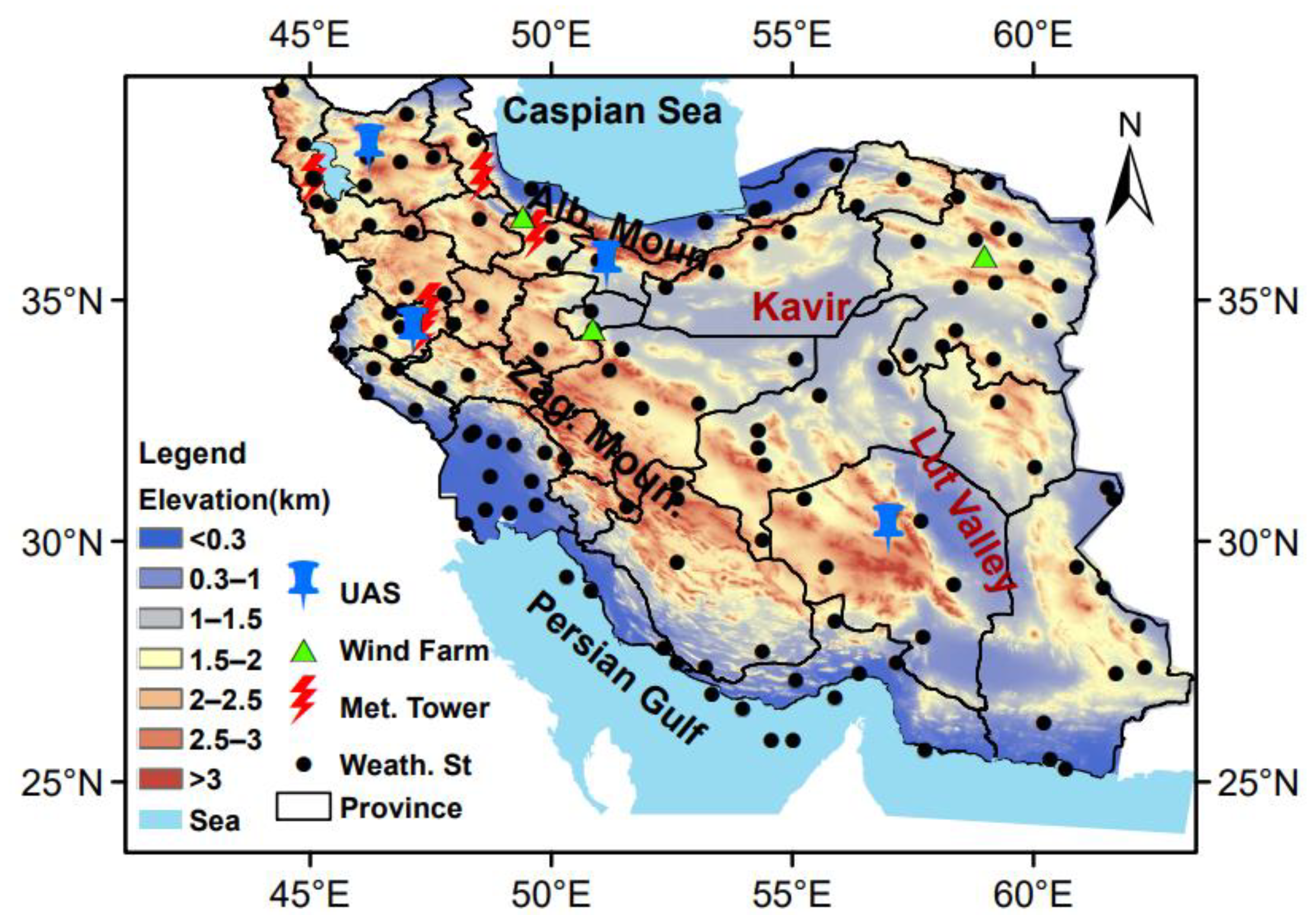
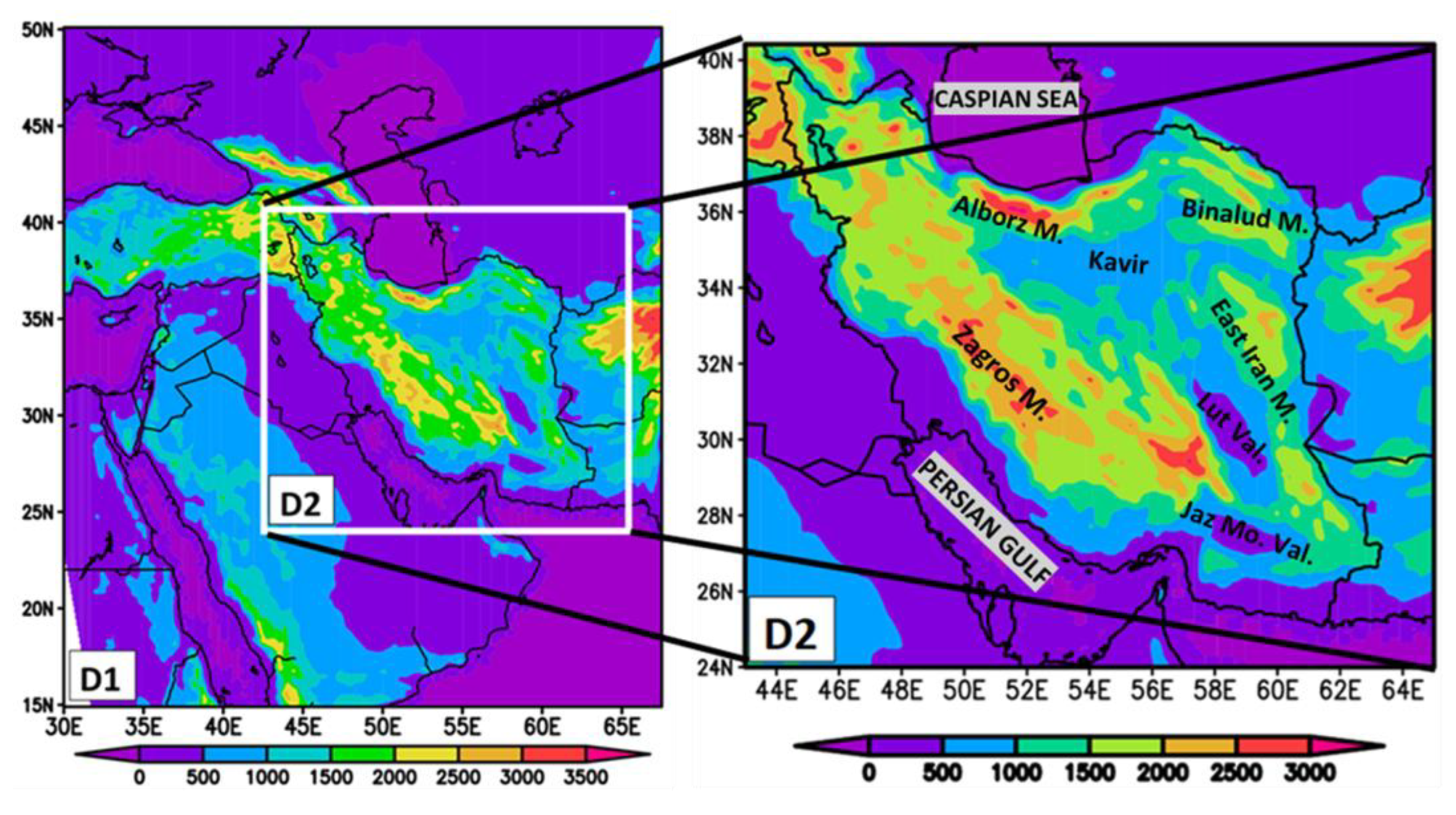

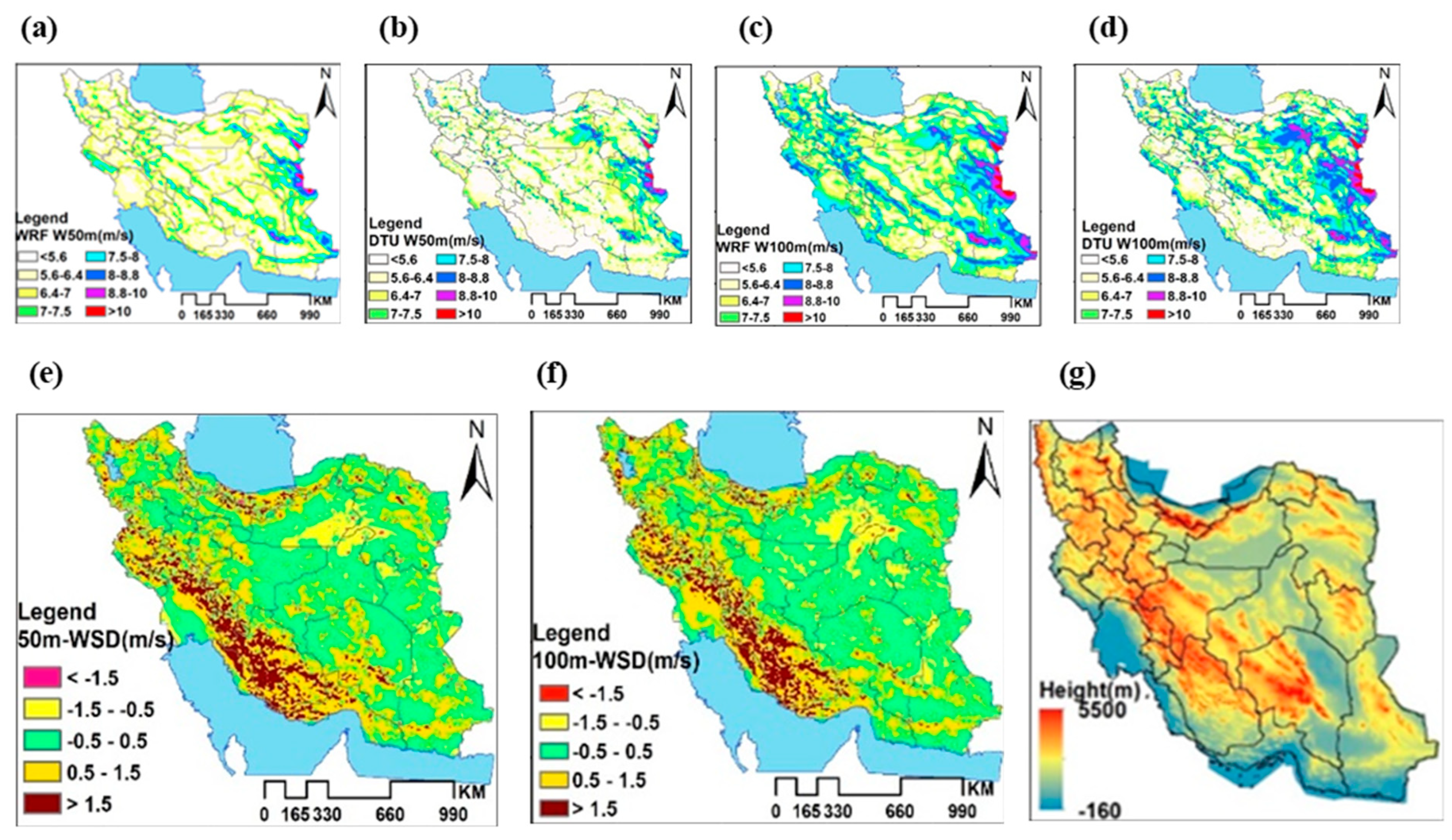
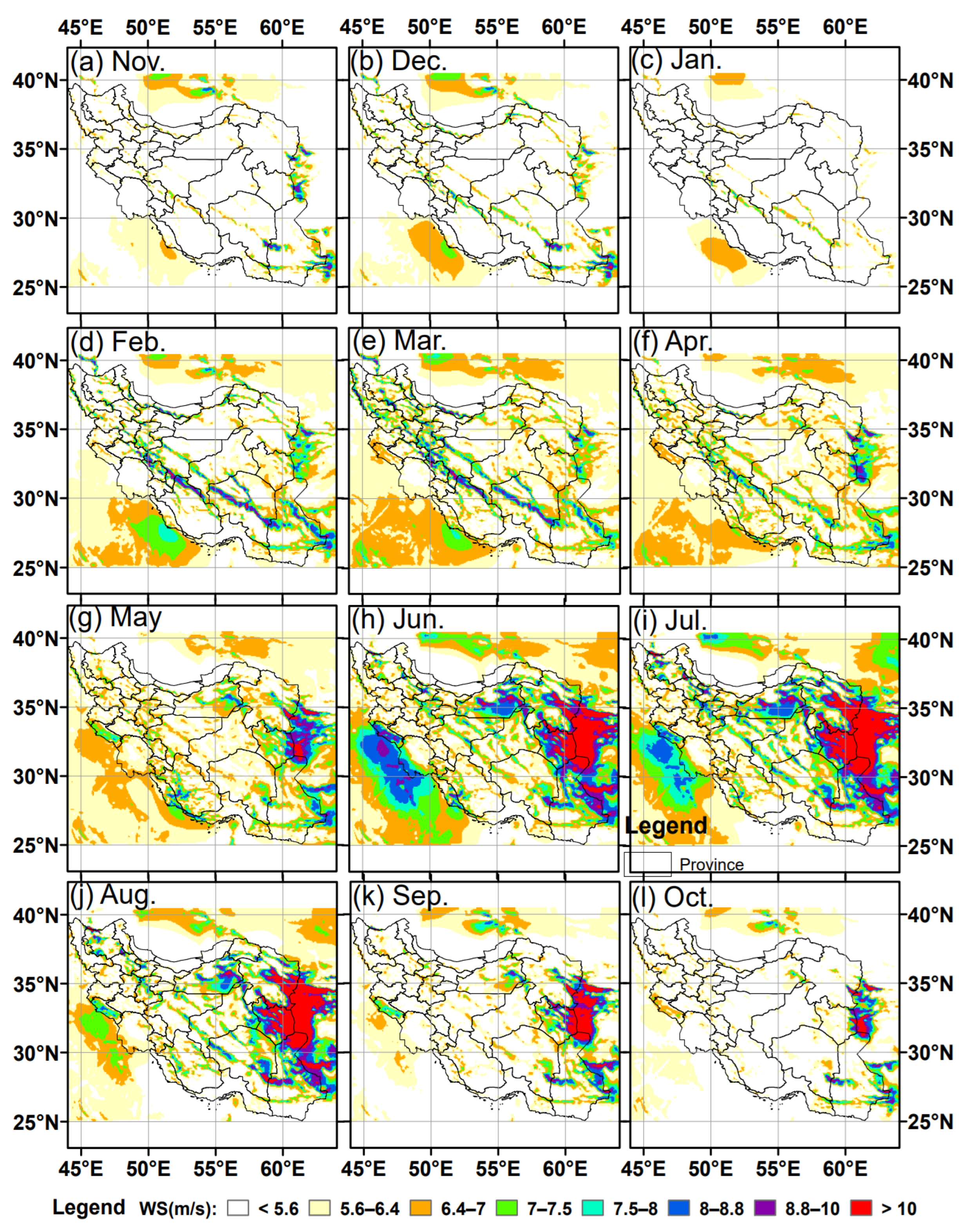
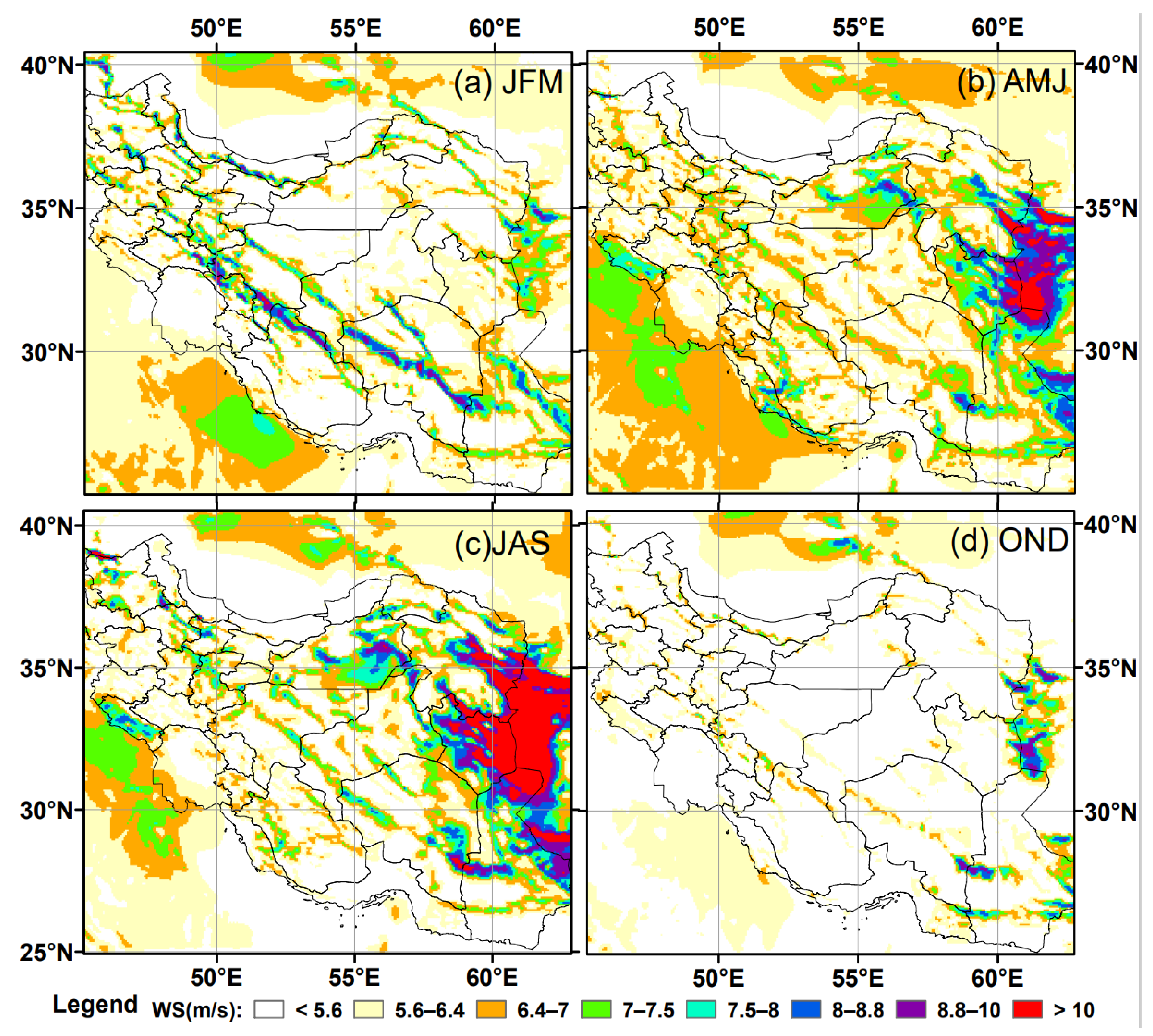
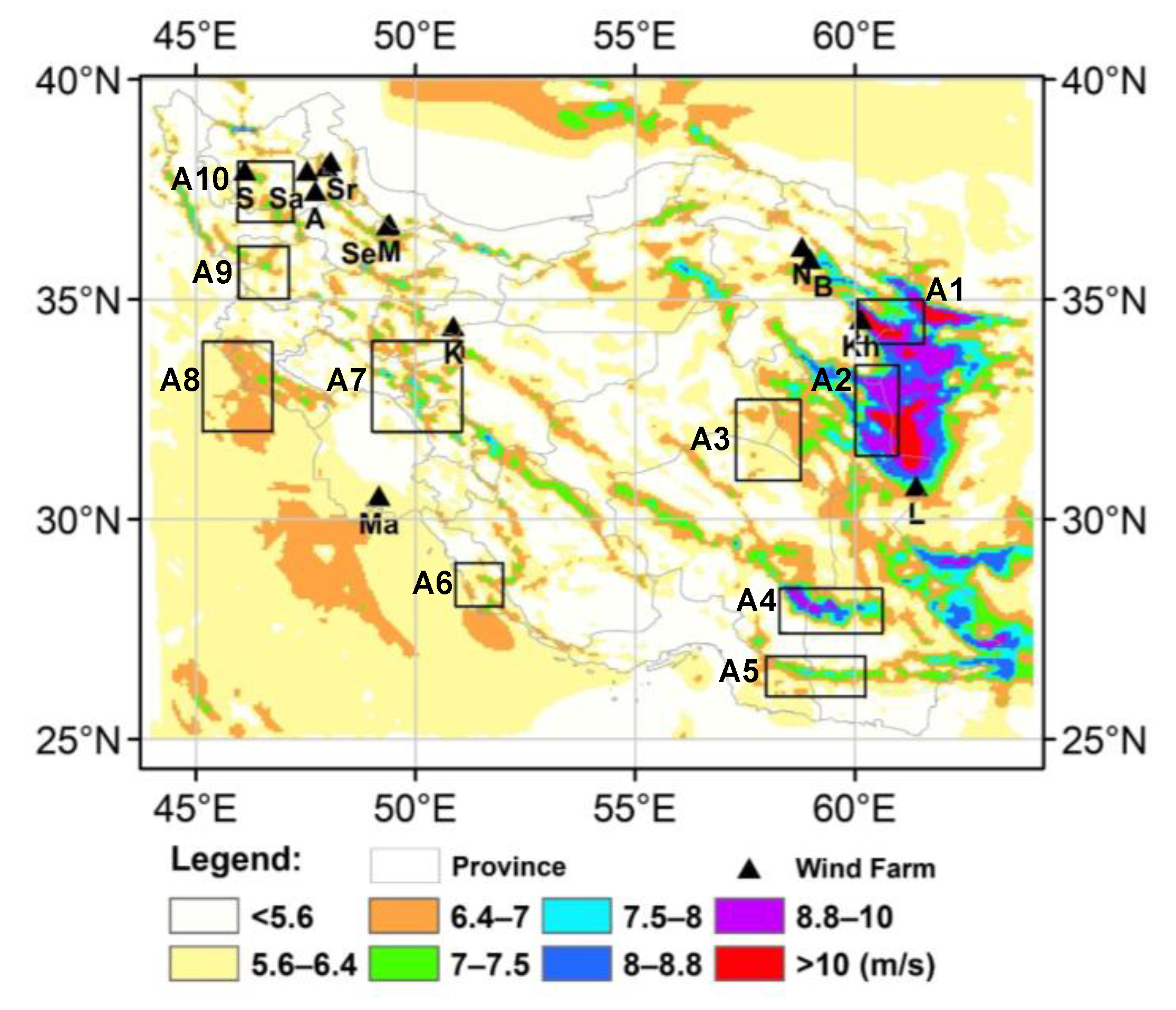
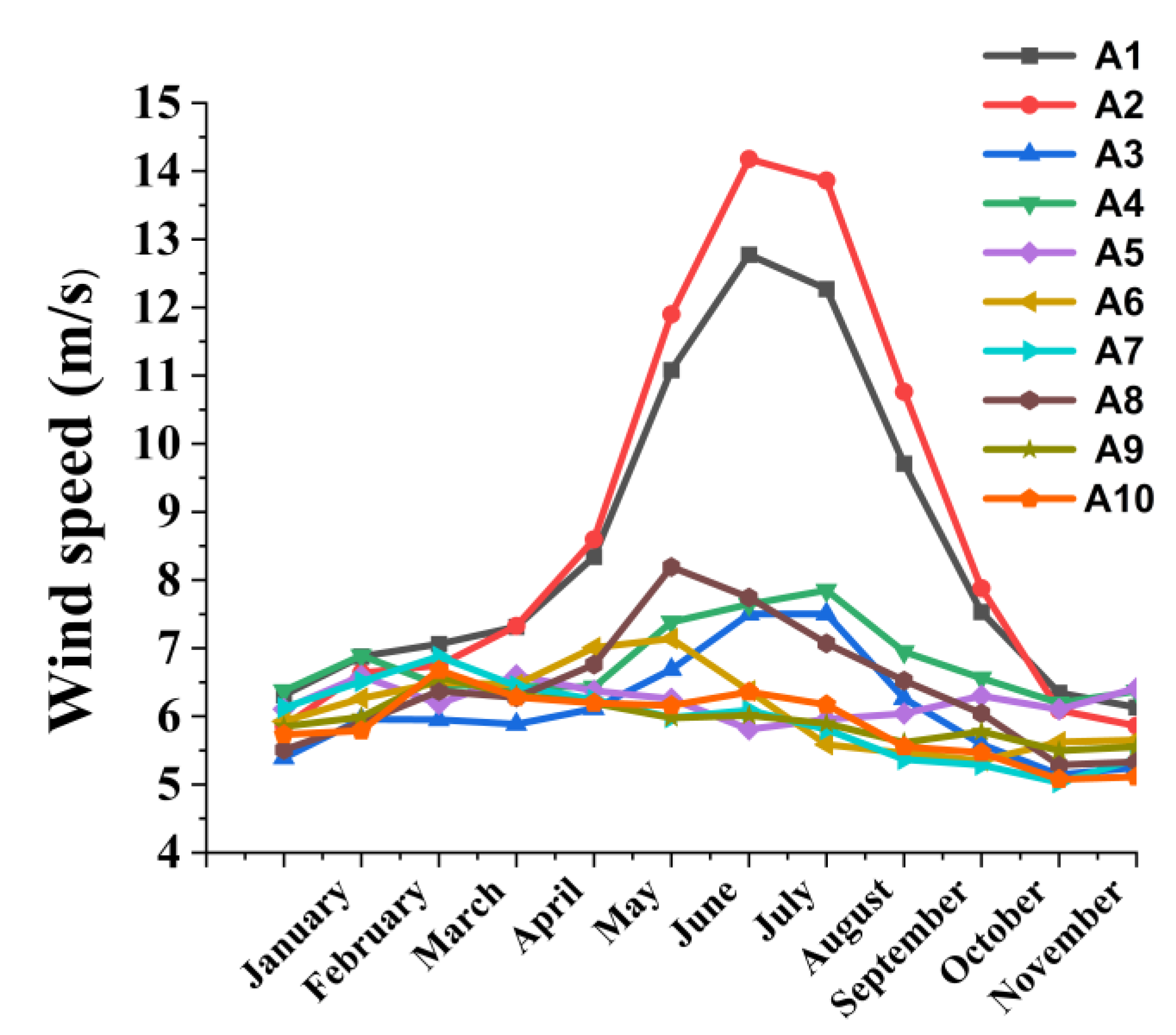
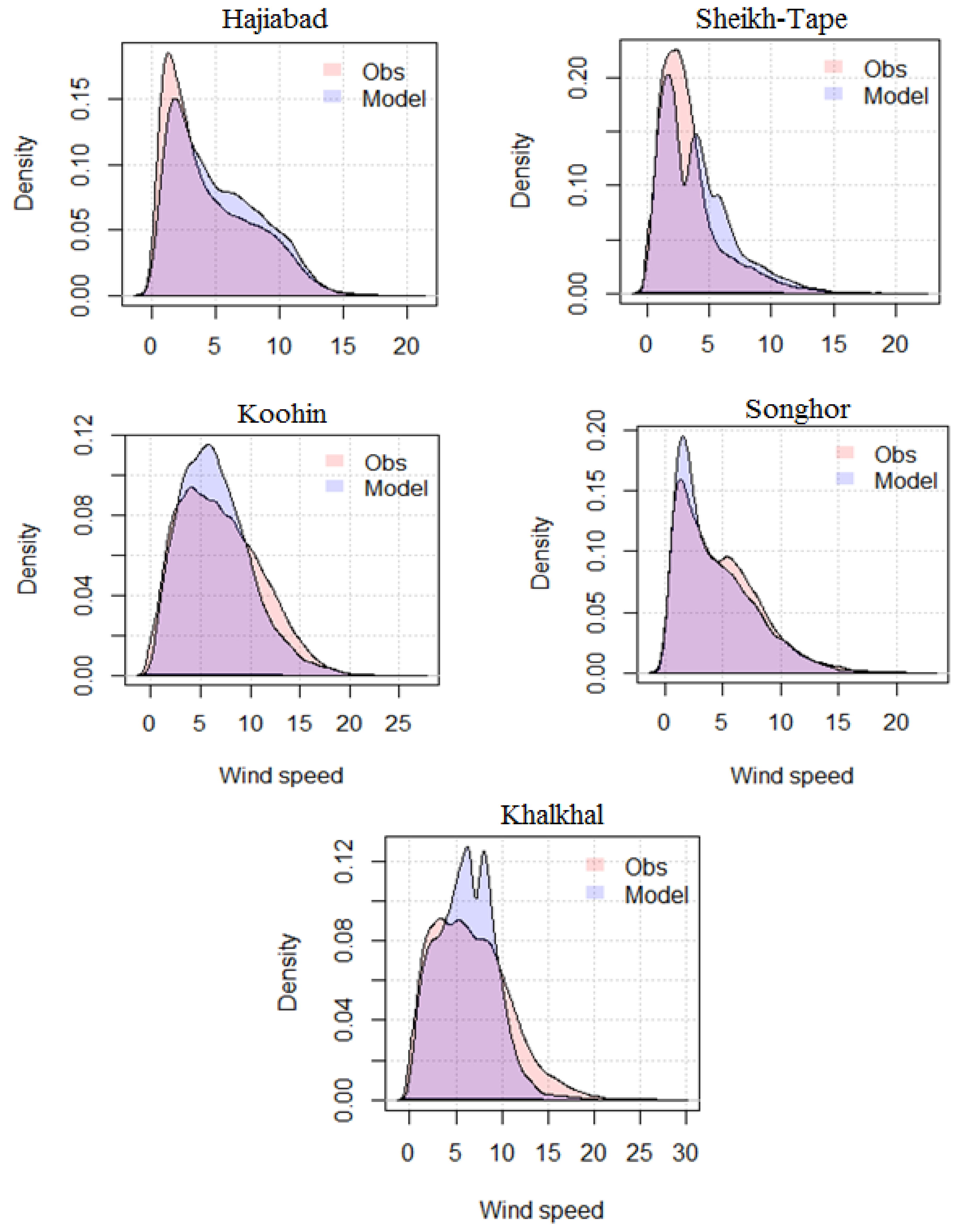
| Synoptic Station | Longitude | Latitude | Hs (m) | Hm (m) | D = Hs-Hm (m) |
|---|---|---|---|---|---|
| Tehran | 35.68 | 51.32 | 1191 | 1144.43 | 46.63 |
| Kerman | 30.25 | 56.97 | 1754 | 1732.34 | 21.1 |
| Kermanshah | 34.35 | 47.15 | 1318.5 | 1393.34 | −74.84 |
| Tabriz | 38.08 | 46.28 | 1361 | 1442.42 | −81.42 |
| Model Setup |
| WRF Version 3.9.1 |
| Domain 1: 274 × 256 grid points and 15 km grid spacing; |
| Domain 2: 391 × 343 and 5 km grid spacing. Two-way nesting domains. 39 vertical levels up to the top of 100 hPa. 6 lowest level heights: approximately at 12, 35, 65, 100, 140 and 200 m. |
| Simulation setup |
| Initial and boundary conditions and fields for grid nudging were taken from ERA-Interim reanalysis with 0.75° × 0.75° horizontal resolution. Simulation length: 60 h including 12 h spin-up (runs were started at 00:00 UTC every 60 h, with an hourly time step and the first 12 h of each simulation were disregarded as the spin-up). Nudging: Grid nudging was implemented in D1 only; above PBL, the nudging coefficient was 0.0003 s−1 for wind, temperature and specific humidity. |
| Spin-up: 12 h |
| Physical parameterizations |
| Microphysics: Lin et al. scheme [73]. A sophisticated scheme that has snow, ice and graupel processes, suitable for real-data high-resolution simulations |
| Longwave Radiation: RRTM scheme. An accurate scheme using look-up tables for efficiency. Accounts for trace gases, multiple bands and microphysical species. |
| Shortwave Radiation: Dudhia scheme [74]. Simple downward integration allowed the efficient estimation of clouds, scattering and clear-sky absorption. |
| The five planetary boundary layers and surface layer used in this study are analytically discussed in the text. |
| Land Surface: Noah Land Surface Model [75]. Unified NCEP/NCAR/AFWA scheme with moisture and soil temperature in four layers, including fractional frozen soil and snow cover physics. |
| Synoptic Station | Longitude | Latitude | Source | Measurement Height (m) |
|---|---|---|---|---|
| Koohin | 36.34 | 49.71 | SATBA | 40, 60 and 80 |
| Khalkhal | 37.54 | 48.57 | SATBA | 10, 30 and 40 |
| Sheikh-Tapeh | 37.52 | 45.08 | SATBA | 10, 30 and 40 |
| Songhor | 34.83 | 47.47 | SATBA | 40, 60 and 80 |
| Hajia-bad-Kermanshah | 34.34 | 47.34 | SATBA | 10, 30 and 40 |
| January 2013 | 10 m | 40 m | 80 m | Average of Three Levels | |
|---|---|---|---|---|---|
| Bias | MYJ | 1 | 0.97 | 0.75 | 0.9 |
| MYNN | 1.87 | 0.77 | 0.74 | 1.12 | |
| ACM2 | 1.25 | 0.7 | 0.83 | 0.93 | |
| YSU | 1.25 | 0.91 | 1.04 | 1.06 | |
| QNSE | 1.03 | 0.69 | 0.63 | 0.78 | |
| RMSE | MYJ | 4.28 | 4.17 | 4.2 | 4.21 |
| MYNN | 4.41 | 4.13 | 4.2 | 4.25 | |
| ACM2 | 4.39 | 4.08 | 4.24 | 4.24 | |
| YSU | 4.44 | 4.18 | 4.3 | 4.31 | |
| QNSE | 4.28 | 4.07 | 4.08 | 4.14 | |
| STDE | MYJ | 4.12 | 4.04 | 4.11 | 4.09 |
| MYNN | 4.18 | 4.05 | 4.12 | 4.12 | |
| ACM2 | 4.16 | 4.01 | 4.06 | 4.07 | |
| YSU | 4.22 | 4.06 | 4.17 | 4.15 | |
| QNSE | 4.12 | 3.99 | 4.03 | 4.05 | |
| July 2013 | 10 m | 40 m | 80 m | Average of Three Levels | |
|---|---|---|---|---|---|
| Bias | MYJ | 0.76 | 0.87 | 1.04 | 0.89 |
| MYNN | 0.26 | 0.87 | 0.99 | 0.7 | |
| ACM2 | 0.68 | 0.5 | 0.62 | 0.6 | |
| YSU | 0.32 | 1.01 | 1.21 | 0.84 | |
| QNSE | 0.31 | 0.88 | 1.08 | 0.76 | |
| RMSE | MYJ | 3.32 | 3.88 | 4.03 | 3.74 |
| MYNN | 3.21 | 3.82 | 3.96 | 3.66 | |
| ACM2 | 3.15 | 3.46 | 3.61 | 3.4 | |
| YSU | 3.25 | 3.75 | 3.97 | 3.66 | |
| QNSE | 3.47 | 4 | 4.2 | 3.89 | |
| STDE | MYJ | 3.12 | 3.65 | 3.75 | 3.51 |
| MYNN | 3.06 | 3.61 | 3.72 | 3.46 | |
| ACM2 | 2.96 | 3.29 | 3.41 | 3.22 | |
| YSU | 3.01 | 3.41 | 3.56 | 3.33 | |
| QNSE | 3.24 | 3.8 | 3.92 | 3.65 | |
| Synoptic Station | Mean Bias | Diff Elevation |
|---|---|---|
| Khalkhal | 0.718 | 20 |
| Songhor | 0.242 | 26 |
| Koohin | 1.068 | 69 |
| Sheikh Tape | 1.392 | 114 |
| Haji-Abad | 2.526 | 496 |
| BE (m/s) | −0.69 ≤ BE < 0 | 0 ≤ BE < 1 | 1 ≤ BE < 2 | 2 ≤ BE < 3 | 3 ≤ BE ≤ 3.71 |
| percentage of stations (%) | 4.55 | 35.45 | 37.27 | 18.18 | 4.55 |
| Month | Number of Stations | ||||
|---|---|---|---|---|---|
| 110 | 101 | 27 | 40 | 43 | |
| BE ≥ 2 m/s | 1 m/s ≤ BE < 2 m/s | BE < 1 m/s | |||
| January | 0.44 | 0.61 | 0.73 | 0.84 | 0.74 |
| February | 0.43 | 0.59 | 0.72 | 0.87 | 0.80 |
| March | 0.39 | 0.56 | 0.64 | 0.85 | 0.80 |
| April | 0.39 | 0.55 | 0.46 | 0.89 | 0.83 |
| May | 0.43 | 0.58 | 0.52 | 0.90 | 0.86 |
| June | 0.67 | 0.75 | 0.78 | 0.93 | 0.92 |
| July | 0.72 | 0.78 | 0.81 | 0.91 | 0.93 |
| August | 0.73 | 0.79 | 0.68 | 0.89 | 0.94 |
| September | 0.62 | 0.72 | 0.70 | 0.91 | 0.92 |
| October | 0.45 | 0.59 | 0.69 | 0.84 | 0.87 |
| November | 0.44 | 0.60 | 0.78 | 0.85 | 0.86 |
| December | 0.44 | 0.59 | 0.80 | 0.83 | 0.82 |
| Annual | 0.49 | 0.64 | 0.71 | 0.93 | 0.90 |
| Area | NG | January | February | March | April | May | June | July | August | September | October | November | December | ANN |
|---|---|---|---|---|---|---|---|---|---|---|---|---|---|---|
| A1 | 682 | 0.02 | 0.01 | 0.01 | 0.01 | −0.06 * | −0.1 * | 0.01 | 0.06 * | −0.03 | 0.06 * | 0.09 * | −0.06 * | 0.00 |
| A2 | 968 | 0.03 | 0.01 | 0.02 | −0.03 | −0.05 | −0.1 * | −0.04 | 0.06 * | 0.01 | 0.03 | 0.06 * | −0.03 | −0.00 |
| A3 | 1287 | 0.02 | 0.01 | 0.01 | 0.00 | −0.02 | 0.01 | 0.01 | 0.04 | −0.01 | 0.03 | 0.02 | −0.02 | 0.09 * |
| A4 | 1122 | 0.01 | 0.03 | 0.01 | −0.01 | −0.02 | 0.03 | −0.04 | 0.1 * | 0.05 | 0.05 | 0.07 * | 0.02 | 0.02 |
| A5 | 864 | 0.02 | 0.00 | 0.01 | −0.03 | −0.00 | 0.01 | −0.01 | 0.01 | 0.05 | 0.05 | 0.08 * | 0.04 | 0.03 |
| A6 | 484 | 0.03 | 0.01 | 0.02 | 0.03 | −0.05 | 0.04 | −0.02 | 0.04 | −0.02 | 0.02 | −0.01 | −0.01 | 0.01 |
| A7 | 1936 | 0.05 | −0.02 | −0.00 | −0.02 | −0.01 | 0.03 | −0.00 | 0.02 | 0.01 | −0.01 | −0.04 | −0.02 | −0.00 |
| A8 | 1452 | 0.01 | −0.01 | −0.01 | −0.05 | −0.00 | −0.05 | 0.01 | −0.01 | −0.02 | −0.06 * | 0.05 | −0.05 | −0.02 |
| A9 | 572 | −0.01 | −0.04 | 0.01 | −0.02 | 0.02 | 0.01 | −0.01 | 0.03 | 0.03 | −0.02 | 0.04 | −0.04 | −0.00 |
| A10 | 729 | 0.01 | −0.05 | −0.03 | −0.01 | 0.01 | 0.02 | −0.02 | 0.02 | −0.01 | −0.03 | −0.02 | 0.01 | −0.01 |
| Station | Mean Wind Speed (m/s) | Median Wind Speed (m/s) | WPD (Wm−2) | |||
|---|---|---|---|---|---|---|
| Model | Observation | Model | Observation | Model | Observation | |
| Hajiabad | 5.068 | 4.458 | 4.358 | 3.420 | 198 | 169 |
| Sheikh-Tape | 3.940 | 3.339 | 3.489 | 2.700 | 112 | 78 |
| Koohin | 6.544 | 6.963 | 6.131 | 6.500 | 339 | 432 |
| Songhor | 4.328 | 4.691 | 3.467 | 4.000 | 151 | 183 |
| Khalkhal | 6.152 | 6.664 | 6.155 | 6.200 | 258 | 416 |
Disclaimer/Publisher’s Note: The statements, opinions and data contained in all publications are solely those of the individual author(s) and contributor(s) and not of MDPI and/or the editor(s). MDPI and/or the editor(s) disclaim responsibility for any injury to people or property resulting from any ideas, methods, instructions or products referred to in the content. |
© 2024 by the authors. Licensee MDPI, Basel, Switzerland. This article is an open access article distributed under the terms and conditions of the Creative Commons Attribution (CC BY) license (https://creativecommons.org/licenses/by/4.0/).
Share and Cite
Saadatabadi, A.R.; Hamzeh, N.H.; Kaskaoutis, D.G.; Ghasabi, Z.; Penchah, M.M.; Sotiropoulou, R.-E.P.; Habibi, M. Optimization and Evaluation of the Weather Research and Forecasting (WRF) Model for Wind Energy Resource Assessment and Mapping in Iran. Appl. Sci. 2024, 14, 3304. https://doi.org/10.3390/app14083304
Saadatabadi AR, Hamzeh NH, Kaskaoutis DG, Ghasabi Z, Penchah MM, Sotiropoulou R-EP, Habibi M. Optimization and Evaluation of the Weather Research and Forecasting (WRF) Model for Wind Energy Resource Assessment and Mapping in Iran. Applied Sciences. 2024; 14(8):3304. https://doi.org/10.3390/app14083304
Chicago/Turabian StyleSaadatabadi, Abbas Ranjbar, Nasim Hossein Hamzeh, Dimitris G. Kaskaoutis, Zahra Ghasabi, Mohammadreza Mohammadpour Penchah, Rafaella-Eleni P. Sotiropoulou, and Maral Habibi. 2024. "Optimization and Evaluation of the Weather Research and Forecasting (WRF) Model for Wind Energy Resource Assessment and Mapping in Iran" Applied Sciences 14, no. 8: 3304. https://doi.org/10.3390/app14083304
APA StyleSaadatabadi, A. R., Hamzeh, N. H., Kaskaoutis, D. G., Ghasabi, Z., Penchah, M. M., Sotiropoulou, R.-E. P., & Habibi, M. (2024). Optimization and Evaluation of the Weather Research and Forecasting (WRF) Model for Wind Energy Resource Assessment and Mapping in Iran. Applied Sciences, 14(8), 3304. https://doi.org/10.3390/app14083304









